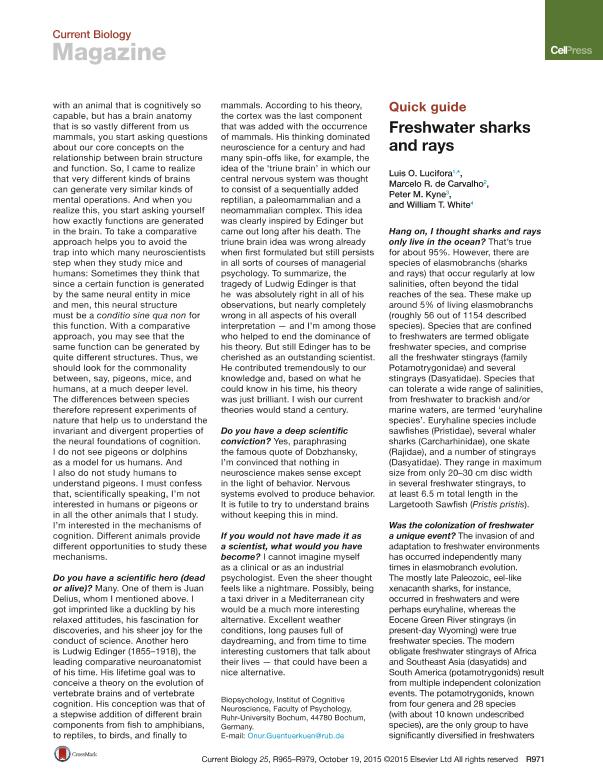Mostrar el registro sencillo del ítem
dc.contributor.author
Lucifora, Luis Omar

dc.contributor.author
Carvalho, Marcelo R. de
dc.contributor.author
Kyne, Peter M.
dc.contributor.author
White, William T.
dc.date.available
2019-06-10T19:02:22Z
dc.date.issued
2015-10
dc.identifier.citation
Lucifora, Luis Omar; Carvalho, Marcelo R. de; Kyne, Peter M.; White, William T.; Freshwater sharks and rays; Cell Press; Current Biology; 25; 20; 10-2015; 971-973
dc.identifier.issn
0960-9822
dc.identifier.uri
http://hdl.handle.net/11336/77875
dc.description.abstract
Hang on, I thought sharks and rays only live in the ocean? That’s true for about 95%. However, there are species of elasmobranchs (sharks and rays) that occur regularly at low salinities, often beyond the tidal reaches of the sea. These make up around 5% of living elasmobranchs (roughly 56 out of 1154 described species). Species that are confined to freshwaters are termed obligate freshwater species, and comprise all the freshwater stingrays (family Potamotrygonidae) and several stingrays (Dasyatidae). Species that can tolerate a wide range of salinities, from freshwater to brackish and/or marine waters, are termed ‘euryhaline species’. Euryhaline species include sawfishes (Pristidae), several whaler sharks (Carcharhinidae), one skate (Rajidae), and a number of stingrays (Dasyatidae). They range in maximum size from only 20–30 cm disc width in several freshwater stingrays, to at least 6.5 m total length in the Largetooth Sawfish (Pristis pristis).
dc.format
application/pdf
dc.language.iso
eng
dc.publisher
Cell Press

dc.rights
info:eu-repo/semantics/openAccess
dc.rights.uri
https://creativecommons.org/licenses/by-nc-sa/2.5/ar/
dc.subject
Sharks
dc.subject
Rays
dc.subject.classification
Otras Ciencias Biológicas

dc.subject.classification
Ciencias Biológicas

dc.subject.classification
CIENCIAS NATURALES Y EXACTAS

dc.title
Freshwater sharks and rays
dc.type
info:eu-repo/semantics/article
dc.type
info:ar-repo/semantics/artículo
dc.type
info:eu-repo/semantics/publishedVersion
dc.date.updated
2019-05-10T14:10:46Z
dc.identifier.eissn
1879-0445
dc.journal.volume
25
dc.journal.number
20
dc.journal.pagination
971-973
dc.journal.pais
Estados Unidos

dc.description.fil
Fil: Lucifora, Luis Omar. Consejo Nacional de Investigaciones Científicas y Técnicas. Centro Científico Tecnológico Conicet - Nordeste. Instituto de Biología Subtropical. Instituto de Biología Subtropical - Nodo Puerto Iguazú | Universidad Nacional de Misiones. Instituto de Biología Subtropical. Instituto de Biología Subtropical - Nodo Puerto Iguazú; Argentina
dc.description.fil
Fil: Carvalho, Marcelo R. de. Universidade de Sao Paulo. Departamento de Fisiología. Instituto de Biociencias; Brasil
dc.description.fil
Fil: Kyne, Peter M.. Charles Darwin University; Australia
dc.description.fil
Fil: White, William T.. Commonwealth Scientific and Industrial Research Organisation; Australia
dc.journal.title
Current Biology

dc.relation.alternativeid
info:eu-repo/semantics/altIdentifier/url/http://www.sciencedirect.com/science/article/pii/S0960982215007459
dc.relation.alternativeid
info:eu-repo/semantics/altIdentifier/doi/http://dx.doi.org/10.1016/j.cub.2015.06.051
Archivos asociados
